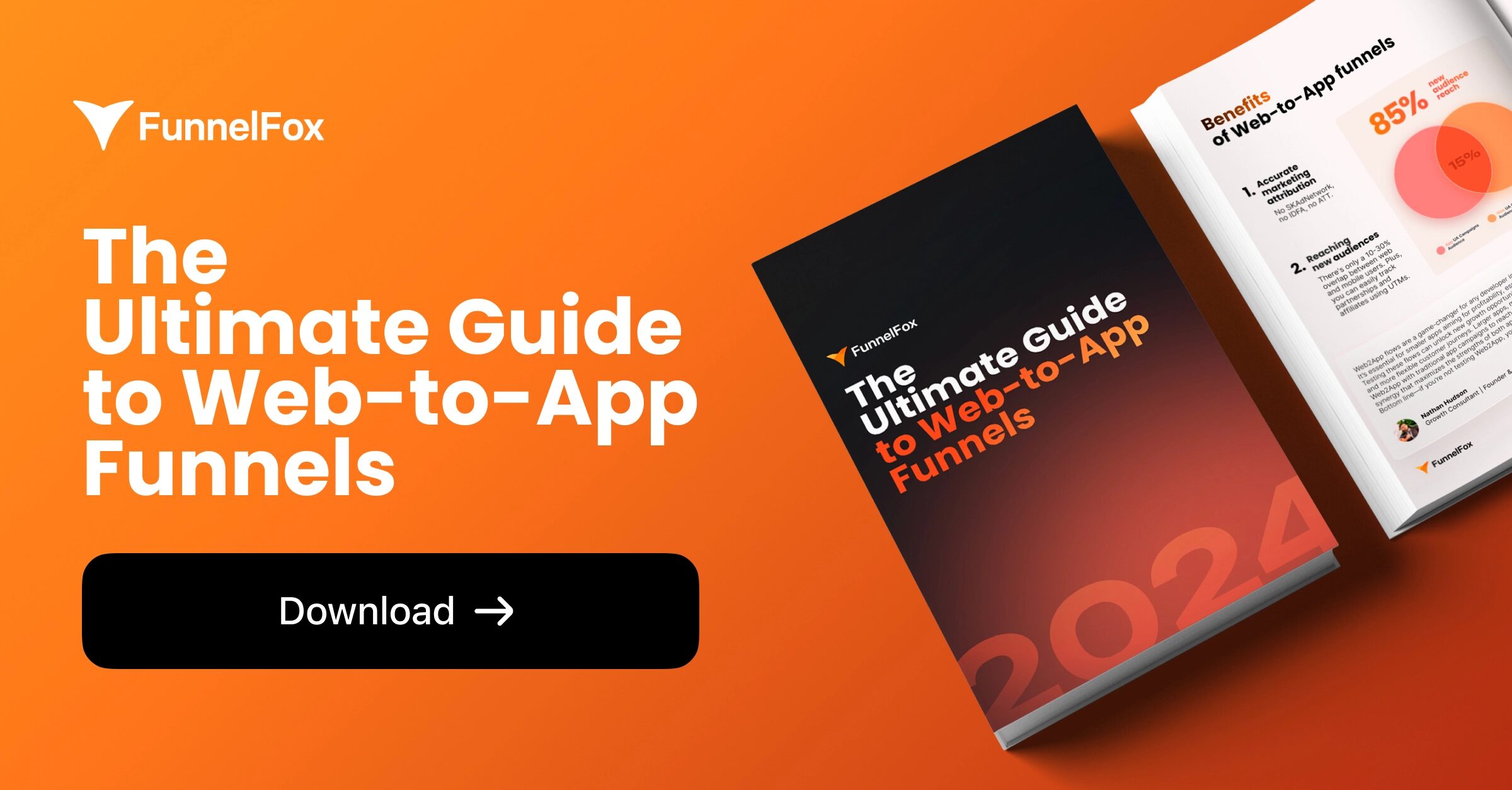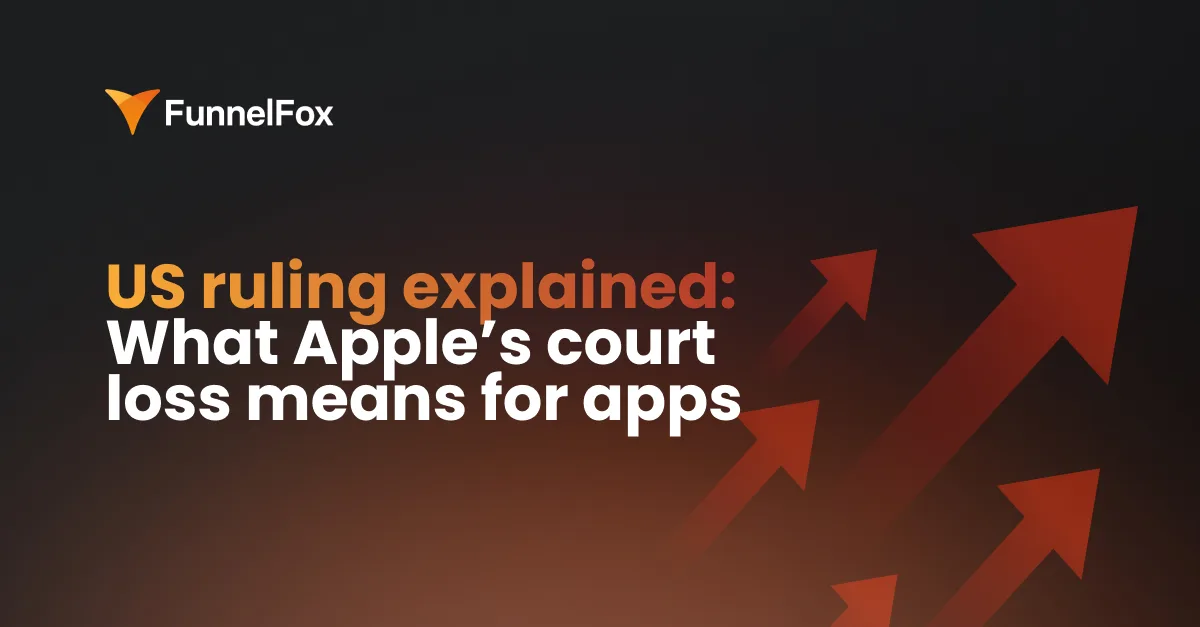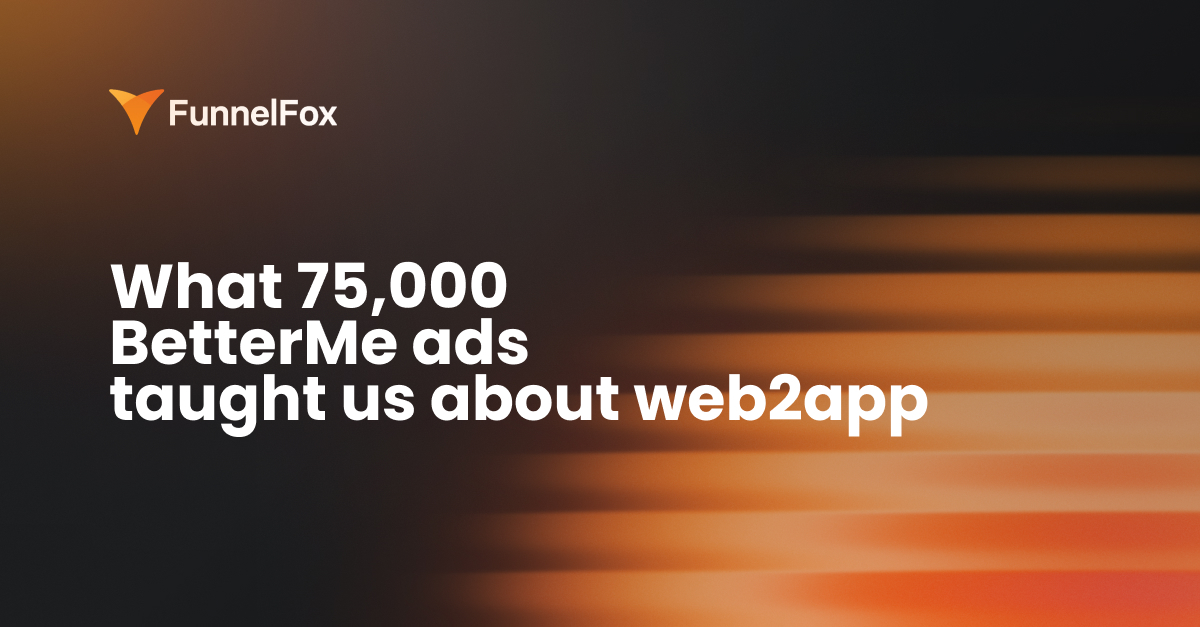Not every app needs a web2app funnel, but yours might. So, how do you know for sure? And once you do, how do you get it right?
Hannah Parvaz (Founder, Aperture), Andrey Shakhtin (CEO & Co-founder, FunnelFox), and Kirill Makarov (Founder, WebFunnels Club) sat down for a live session to talk it all through, and we’ve pulled together the key takeaways in this blog. Read on to learn where web2 app funnels can make the biggest difference, why they’re worth testing, and how to make them work.
Prefer to watch instead? There’s a webinar recording waiting for you at the end.
What’s the big deal with web2 app funnels?
A web2 app funnel is a user journey that starts on a website instead of going straight to the app store. You’re sending traffic to a web experience — whether that’s a quiz funnel, a landing page, a blog post, or a download page — before prompting the install.

This gives you more room to onboard users, explain your value, and convert them on your terms. It can include payment, segmentation, or just warming them up, depending on your goals.
Here’s what makes web2 app so effective:
1. More revenue, faster payout
When users pay through the App Store or Google Play, you lose a cut: 15% if your annual revenue is under $1 million, and 30% if it’s above. Web2 app funnels bypass those platform fees. You only pay for payment processing, which usually lands around 2–5%.
Plus, web payments land in your account in a day or two, while store payouts often take weeks. That speed gives you more control over cash flow and more opportunities to reinvest.
2. Flexible, personalized, and fully controlled user journeys
Retention is often higher in web2 app, and not by accident. When you control the full experience, you can design it to keep users around. That starts with web onboarding and pricing, but matters even more at cancellation.
On the web, you’re not stuck with a generic cancel button. You can ask why they’re leaving, offer a discount, suggest a cheaper plan, or let them pause instead of cancel. Each of these actions catches users who would’ve otherwise churned and pulls some of them back in.
It also lets you recover value in a more thoughtful way. Users who stay, even at a reduced plan, are more likely to upgrade later. And when this retention logic is built into your funnel, not just in the app, it improves both user LTV and acquisition efficiency.
3. Access to first-party data & precise attribution
iOS privacy updates in 2021 killed much of the visibility marketers relied on. Web2 app gives you back what was taken away — 100% attribution, real-time performance data, and visibility into user-level behavior — so that you can see every step, from ad click to purchase. This leads to faster learning cycles and more informed decisions in both marketing and product development.
In practice, the difference is massive. Companies that applied media mix modeling to compare performance saw just how big the gap really is. Web2 app funnels recovered up to four times more data than app flows simply because they didn’t rely on delayed, broken, or view-through tracking.
“We’ve seen up to 4x more data in web2 app funnels — data that we were missing before due to issues like view-throughs or broken tracking,” said Hannah.
A closer look: Why web outperforms AEM
Web2app funnels don’t just give you more data; they give you better data. That becomes especially clear when you compare them to Meta’s Aggregated Event Measurement (AEM), which many marketers rely on for iOS campaigns.
AEM is a probabilistic model. It doesn’t track real user behavior, but estimates it. The numbers can vary depending on the platform you’re looking at, and they rarely match what’s happening in product analytics tools. With mobile app funnels, there’s no guessing. Every click, conversion, and session is real and traceable.
That accuracy pays off. You can connect ad campaigns directly to product metrics like retention and engagement and see which creatives bring in high-value users. And because you control the full post-click experience, including the cancellation flow, you can actively improve retention instead of just watching it drop.
How to tell if web2 app is the right move for you?
If your app needs more than a few seconds to explain or if you’re already onboarding users inside the product, there’s a strong chance a web2 app funnel will work.
Funnels are especially useful when users need context before they install, when store conversion rates are flat, or when you want more control over messaging, pricing, and segmentation.
One powerful format is quiz-based personalized onboarding. It’s a strong fit for products with multiple use cases or user segments. If people come in with different goals, needs, or behaviors, a quiz helps route them to the right experience and makes the flow feel personal from the first screen.
“When your product serves different segments with different jobs, you can apply quizzes just to personalize your product to these use cases,” said Andrey.
That upfront personalization improves both conversion and subscription retention.
Strong fit: products that require trust or education
Technically, web2 app can work for any app category, but it shines best in those that need to build trust or educate users before the install:
- Health & Fitness
- Mental health
- Relationships
- Finance
- Learning and EdTech
- Habit-building products
These are categories where users often need more context before they’re ready to download or subscribe. The web gives you the space to provide that upfront.
Also works: B2B tools, utilities, photo apps, games
Funnels can also work in less obvious categories, as long as you find the right angle. B2B products benefit from clearer positioning and messaging. Utilities like VPNs, file cleaners, or even flashlight apps can use listicles or advertorials to reframe value. For example, a “Top 5 VPNs” article or a comparison page can drive qualified traffic.
Games and photo editors now use quizzes to personalize the experience, like helping users choose the right filter or game type. This approach didn’t exist in the category until recently, but web2 app funnels have proven effective.
Content also plays a big role here. Listicles and quizzes don’t just drive clicks — they warm up the audience.
“People who would download from a page like that had a much higher conversion to paying, like 4x what organic would be,” shared Hannah. When users land with context and curiosity, they’re far more likely to convert.
Web2 app funnels work at any stage, not just for mature products
It’s easy to think that web2 app funnels only make sense once a product is launched and scaling. In reality, they work just as well (and sometimes even better) at earlier stages.
Some teams use web2 app funnels before the app is live, simply to test direction.
“We are launching a web2 app funnel to test out propositions, to test which directions are going to be working. That’s very common,” said Hannah.
It’s a fast, low-risk way to validate messaging, pricing, or user intent before investing in development.
Funnels also work for mature products. If you already have high-performing creatives and onboarding in the app, you can repurpose that to web and start optimizing from day one. It takes little to setup, and the upside can be massive.
If I can take payments inside the app now, do I still need a web2 app funnel?
Fair question, and the short answer is: web2 app just got even stronger.
New Apple rules (currently US-only) now allow apps to include a link to a web payment flow or even add an Apple Pay button inside the app, without destroying the organic user journey.
As Hannah explained, “You can link out from your app to a payment flow, but you can also have an Apple Pay button inside your app… and not disrupt your actual organic flow.”
But reduced platform commissions aren’t the main reason to keep web in play. As Kirill pointed out, the core benefit is still attribution. The web gives you clean data and full visibility. Now, you can start the journey on the web, capture high-quality signals, and then upsell inside the app, without paying twice.
What it takes to launch a web2 app funnel
You don’t need a big team or months of development to get started with web2 app funnels. In fact, most teams launch with just a few people and a basic stack of tools, especially when using plug-and-play platforms.
Tools to build and run your funnel
The fastest way to launch is with a ready-made funnel builder like FunnelFox, which has an AI tool that builds a working funnel based on your App Store URL — in literally one minute. For web2 app payments, teams typically choose between:
- DIY setup: Using Stripe or Prime, but managing taxes, chargebacks, compliance, and accounting on your own.
- Merchant of Record: Services like Paddle, which handle taxes and legal risk for a slightly higher fee.
If you go the DIY route, expect more work on the backend, including separate tax reports for every country where you sell. If you don’t have strong accounting support, this can become a bottleneck fast.
Analytics and attribution setup
You’ll also need a way to analyze performance across the funnel. That usually means:
- Product analytics (Amplitude, Mixpanel, GA)
- Conversion tracking (Meta’s Conversions API or similar)
- Server-side connections between web and app (deep linking, event passback)
As Kirill pointed out, if you run traffic to the web, you don’t need a mobile measurement partner unless you’re bridging attribution into the app.
What kind of team does it take?
Most companies get started with just 1–3 people. The key roles are:
- Strategy & funnel ownership — someone who understands CAC, LTV, pricing, and conversion logic.
- Creative & user acquisition — someone to produce ads and manage spend.
- Funnel operations — someone who can build, test, and iterate the web flow.
Often, the same person wears multiple hats. “I know solo founders doing this alone,” said Kirill. Tools lower the technical bar — what matters most is speed and focus.
Budget and timeline: What to expect
Web2 app funnels are faster to build than full onboarding flows inside the app, but they still require a real budget to test properly. There’s no fixed number, but most teams land somewhere between a $5K–$10K minimum to get started and $30K–$50K to get meaningful results.
As Hannah explained, just optimizing for Meta requires 50 conversions per week. If your cost per action is $20, that’s $1,000 a week minimum (and that’s before creative testing, tooling, or team time).
“Safe estimate is like $30K–$50K… but I’ve seen cases where $5–10K was enough, and others where $300K wasn’t,” said Kirill. Even when teams copy a competitor’s funnel and creatives, CPMs and platform noise can derail results.
Other cost drivers include:
- Creative testing. Not just one or two ads a month. High-performance teams launch 10–20 per week.
- Pixel seasoning and algorithm learning. Meta needs time to learn what good traffic looks like.
- CPM fluctuations. Seasonal shifts and auction pressure can change your economics quickly.
The fastest way to burn a budget? Launching one test, getting bad results, and assuming funnels don’t work. These systems need iteration and enough spending to generate real learning.

3 pitfalls to avoid
1. Weak checkout experience
One of the most overlooked parts of the web funnel is the checkout. But it’s also one of the most powerful. If your pricing feels off, or your value isn’t clearly communicated at the moment of purchase, conversion drops, and the wrong users may end up subscribing. That hurts retention and LTV.
As Kirill put it, checkout isn’t just the final step — it’s a signal amplifier: “You’ll start getting signals from the right users who purchase at these prices… and optimizations will be changed.” Small tweaks to copy, layout, or offer structure can dramatically shift your performance.
2. Not shipping enough creatives
Many teams don’t produce nearly enough creative volume to make the web funnel work. As Hannah shared, “One company had 20 million users and only launched 1–2 new creatives per month.” By contrast, her team ships 13–20 per week, even for smaller accounts.
Why? Because frequencies are going up, broad targeting is standard, and Meta’s algo relies on matching creative to user intent. If you aren’t refreshing often, your ads stagnate and performance drops fast.
3. Being afraid to sell
When founders are uncomfortable selling, it shows, especially at the moment of conversion. Instead of making the value clear and irresistible, they downplay it or bury the ask behind vague messaging.
“We were a bit shy,” one founder told Hannah about their early monetization attempt. “We didn’t really communicate what users got.”
When they started confidently showing benefits and explaining the value behind the subscription, their monetization jumped to the point where 25% of US users started paying.
Being clear, bold, and specific at the point of sale is not aggressive — it’s respectful. It tells users what they’re getting and why it’s worth paying for.
Now that you know whether web funnels are right for you (and how to set them up for maximum impact) it’s time to give them a try. With FunnelFox, you can launch a web2 app funnel in under an hour. Onboarding, paywalls, checkouts, A/B tests, and all — without coding. Book a demo and try it in action.










